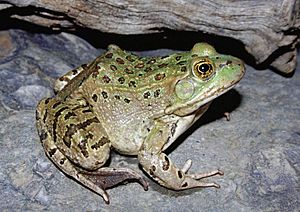Chiricahua leopard frog facts for kids
Quick facts for kids Chiricahua leopard frog |
|
|---|---|
 |
|
| Conservation status | |
| Scientific classification | |
| Synonyms | |
|
The Chiricahua leopard frog (scientific name: Lithobates chiricahuensis) is a special type of frog. It belongs to a group called "true frogs." These frogs are known for their unique spots, which look a bit like a leopard's!
Contents
Where Do Chiricahua Leopard Frogs Live?
These amazing frogs live in North America. You can find them in parts of Mexico and the southwestern United States. Specifically, they live in Arizona and New Mexico.
The frog's name, Chiricahua, comes from the Chiricahua Mountains in Arizona. This is where scientists first discovered this species!
What Kind of Places Do They Like?
Chiricahua leopard frogs love places with water. Their natural homes include:
- Cool, temperate forests
- Clear rivers and streams
- Wet swamps
- Freshwater lakes and ponds
- Marshy areas and springs
They also like open areas where water collects, like old mining pits. As long as there's clean water, they can make a home there.
Why Are These Frogs Important?
The Chiricahua leopard frog plays a role in its ecosystem. Like many frogs, they help control insect populations. They also serve as food for other animals, like birds and snakes. This makes them an important part of the food web.
Helping the Chiricahua Leopard Frog
Sadly, the Chiricahua leopard frog is facing big problems. Its numbers have dropped a lot. This is mainly due to two main reasons:
- Habitat Loss: Many of the places where these frogs used to live are disappearing. This can happen when land is used for building or farming.
- Chytrid Fungus: This is a serious disease that affects amphibians like frogs. It's caused by a tiny fungus that can make frogs very sick.
Because of these threats, the frog has disappeared from about 80% of its original home.
What People Are Doing to Help
Many groups are working hard to save the Chiricahua leopard frog. For example, the Phoenix Zoo in Arizona is helping. So are the Arizona Department of Game and Fish and the U.S. Fish and Wildlife Service (USFWS).
They are trying to:
- Breed frogs in captivity: This means raising frogs in safe environments like zoos.
- Reintroduce them: Once the frogs are old enough, they are released back into safe parts of their natural habitat.
These efforts help increase the number of frogs and protect them from diseases in the wild.
Frog Family Connections
Scientists study the DNA of frogs to understand their family trees. In 2011, a study showed something interesting. The Chiricahua leopard frog might be very closely related to the Vegas Valley leopard frog. The Vegas Valley leopard frog is now extinct, meaning it no longer exists.
Another frog, the Ramsey Canyon leopard frog, was also found to be the same species as the Chiricahua leopard frog. This helps scientists understand how different frog populations are connected.



